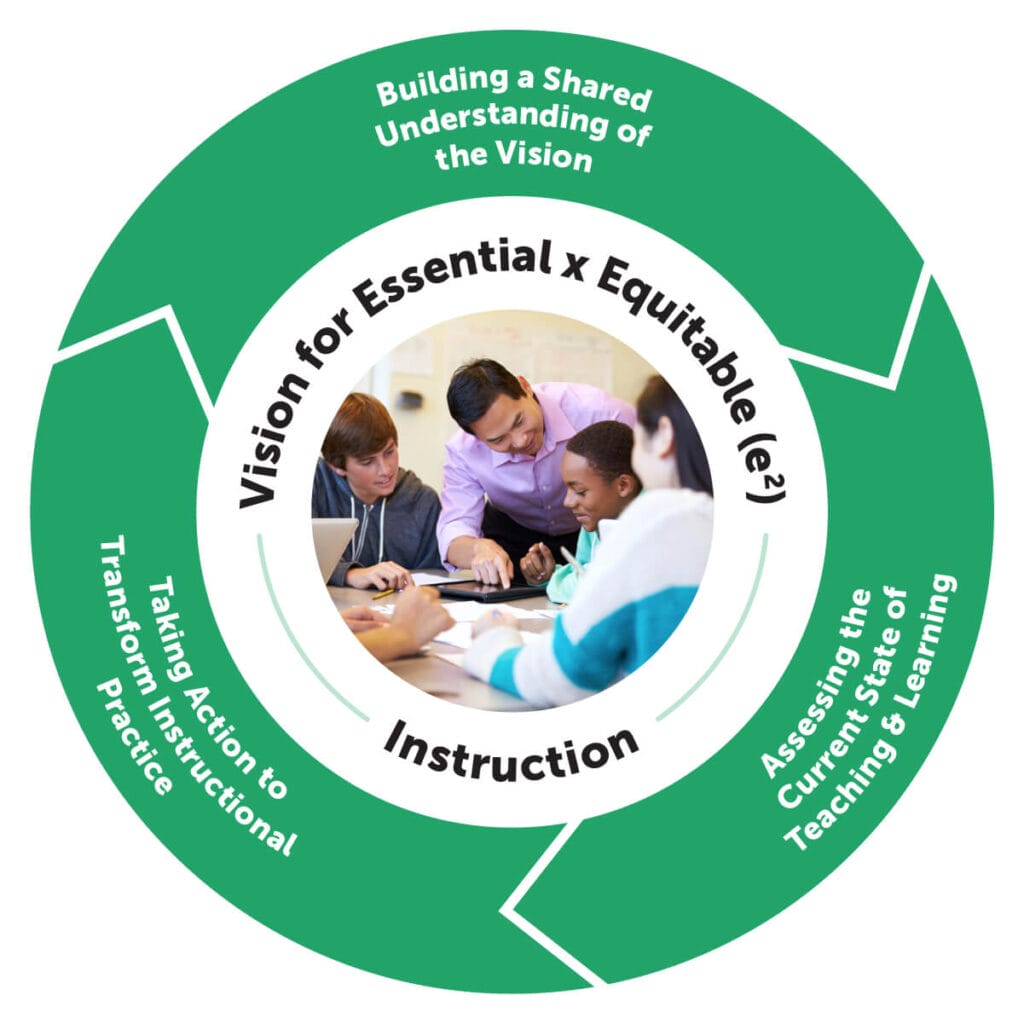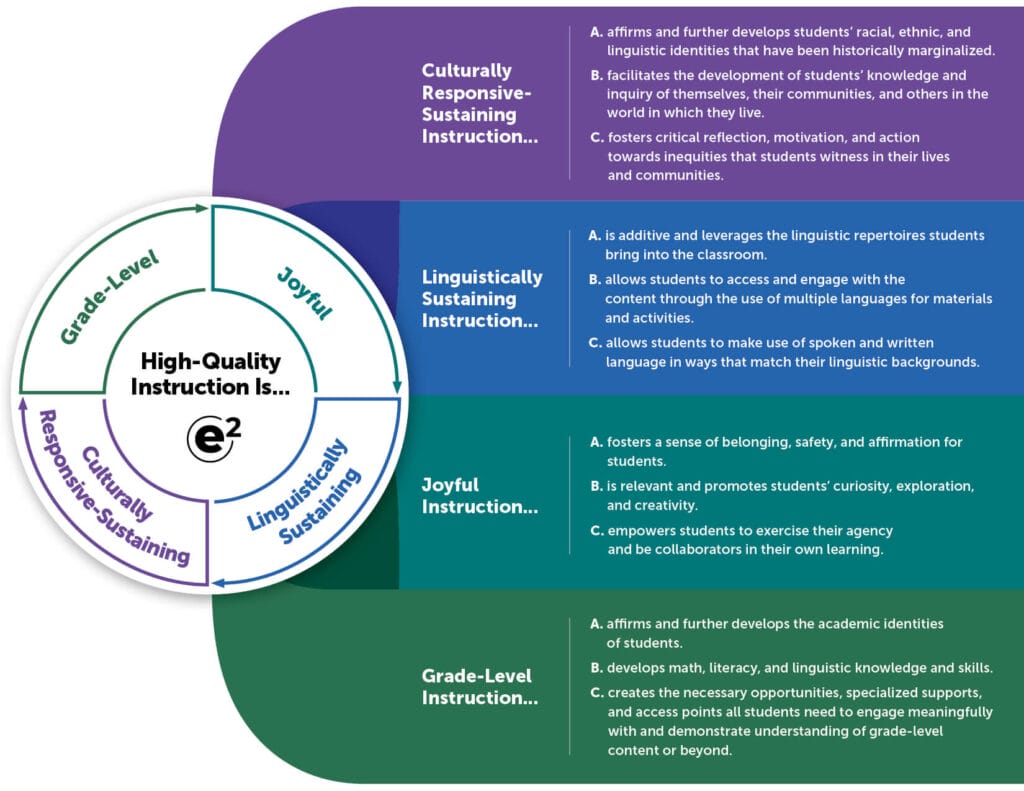

Across the country, educators and those who support them are working to deliver high-quality instruction to the students they serve. Often, that work is made harder by structures and practices that position departments, resources, and approaches in competition with one another. The Essential X Equitable (e²) Instructional Practice Suite™ offers a path to coherence so that we can collectively work more effectively towards providing the education that students deserve, together.
We created the e² Instructional Practice Framework ™ and accompanying e² Suite of Tools ™ to offer a transformative understanding of high-quality math and literacy instruction in K-12 learning environments. We know that access to grade-level instruction for all students is a necessary piece of creating more equitable education outcomes, but is not sufficient on its own. The e² Instructional Practice Framework™ presents an evidence-based definition of high-quality instruction that expands beyond just grade-level to encompass other essential components.
We pulled together the most current and relevant research in the field to build out the e² Instructional Practice Framework ™ . The framework brings together often disconnected strands of research on instructional practice and practitioner knowledge to support and guide change with a cohesive vision of student-centered, high-quality instruction. The e² Suite of Tools ™ is grounded in the e² Instructional Practice Framework ™ and supports educators in bringing this research into practice at scale.
“Our e² Instructional Practice Suite™ is both essential and equitable. It focuses on and commits to joy. It welcomes the wholeness of students’ lives and expects the task to welcome that wholeness as well. It is standards-aligned and whole-child welcoming. It, simply, is what great teachers have always known great instruction to be.”
Joy Delizo-Osborne, President, Student Achievement Partners
The e² Instructional Practice Suite™ is a set of research and evidence-based resources designed to equip instructional leaders with the tools to do three things: build a shared vision, understand the current state of teaching and learning in their schools relative to that vision, and take action to further deliver on the promise of relevant, engaging, grade-level instruction for all students.

The Framework provides the research-base that can support instructional leaders in building a vision for high-quality instruction that is both essential and equitable. This Framework is a foundation —it is meant to be combined with other tools to form a coherent system of structures, policies, and practices aligned to that vision.
The Learning Walk Tool (LWT), developed from the Instructional Practice Guide (IPG), is available in two versions: mathematics and literacy. These tools gather non-evaluative data to create a snapshot of the teaching and learning across classrooms and/or schools through a series of brief classroom visits. Learning walks guided by the LWT intentionally elevate students’ experiences in the classroom by considering interactions between students, teachers, and content.
This set of resources is designed to capture authentic perspectives of teachers and students that reflect the realities of the classroom. Too often, data collection processes focus solely on grade-level outcomes while neglecting the aspects of lived experiences that contribute to equitable instruction, which can’t be as easily quantified. These tools allow for an additional input into data collection processes that elevate the voices, leverage the assets, and honor the brilliance of students and teachers.
The coaching toolkit is a set of resources that supports educators to engage in personalized growth in e² classroom practice. This set of tools aims to humanize the coaching process, transforming instructional practice and amplifying student learning by grounding in the research and evidence-based strategies named in the e² Instructional Practice Framework™ and the indicators from the e² Learning Walk Tools™.
If you currently use the Instructional Practice Guide (IPG) and want to learn more about how the tools in the e² Instructional Practice Suite™ build on that foundational resource, download the FAQ below.

Use the links below to sign up and download the tools.
This free course provides a brief overview of the e² Instructional Practice Framework™, what it is, how it was created, and how and why this resource can support action towards a vision for instruction that is both essential and equitable. Course participants explore the structure of the framework and hear more about its intentional design and research-base. This learning supports building understanding of the four key categories that define high-quality instruction: grade-level, joyful, linguistically sustaining and culturally responsive-sustaining.
This free course provides a brief overview of the e² Learning Walk Tool™ (math / literacy) that was developed from the e² Instructional Practice Framework™. You will build a deep understanding of how the tool was developed, how to use it when conducting observations, and the process for interpreting and synthesizing the data collected. Opportunities to practice and look for indicators across all four categories are included.
These tools are created to work together.By adopting additional tools alongside the framework, districts will build knowledge, skill, and fluency in their use as they integrate them into district work over time.
These tools are flexible.Every district has their own language and focus. Engage with Student Achievement Partners to adapt tools to reflect specific language, align to instructional materials, and implement across a variety of contexts.
These tools are designed for collaboration.Use the tools and processes to both build understanding of the vision and high-quality instruction across the system and collect input from students and teachers to create a more full, textured picture.
These tools are built with educators, for educators.The most effective tools are grounded in both the latest pedagogical research and educator insights into what works in the classroom. These tools are designed in collaboration with educators to be put into practice in the real world.